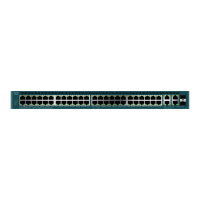IP Configuration: RIPv2
Configuring RIP
Cisco 500 Series Stackable Managed Switch Administration Guide Release 1.3 350
18
• Key Password—If Te x t was selected as the authentication type, enter the
password to be used.
• Key Chain—If MD5 was selected as the authentication mode, enter the key
chain to be digested. This key chain is created as described in the Key
Management section.
• Distribute-list In —Select to configure filtering on RIP incoming routes for
the specified IP address(es) in the Access List Name. If this field is enabled,
select the Access List Name below:
• Access List Name—Select the Access List name (which includes a list of IP
addresses)) of RIP incoming routes filtering for a specified IP interface. See
Creating an Access List for a description of access lists.
• Distribute-list Out—Select to configure filtering on RIP outgoing routes for
the specified IP address(es) in the Access List Name. If this field is enabled,
select the Access List Name below:
• Access List Name—Select the Access List name (which includes a list of IP
addresses)) of RIP outgoing routes filtering for a specified IP interface. See
Creating an Access Listfor a description of access lists.
STEP 3 Click Apply. The settings are written to the Running Configuration file.
Displaying RIPv2 Statistic Counters
To view the RIP statistical counters for each IP address:
STEP 1 Click IP Configuration > RIPv2 > RIPv2 Statistics.
The following fields are displayed:
• IP Interface—IP interface defined on the Layer 2 interface.
• Bad Packets Received—Specifies the number of bad packets identified by
RIP on the IP interface.
• Bad Routes Received—Specifies the number of bad routes received and
identified by RIP on the IP interface. Bad routes mean that the route
parameters are incorrect. For example, the IP destination is a Broadcast
address, or the metric is 0 or greater than 16
• Updates Sent—Specifies the number of packets sent by RIP on the IP
interface.

